Feature Article 1: The Relationship Between GDP and Employment
INTRODUCTION
Over the past 12 months there has been significant interest in the relationship between movements in economic activity represented by GDP growth and movements in the labour market represented by employment growth. In particular, commentators have been interested by the ongoing strength in the labour market relative to the weaker movements in GDP. This article presents a description of the relationship between these two variables with a particular focus on the way in which movements in time series are analysed and the historical relationship between the variables. Some thoughts as to the nature of the relationship between the two series are also provided, although no definitive explanation of the pattern observed in the last 12 to 18 months is given.
THE ANALYSIS OF TIME SERIES
Estimates of GDP indicate that the economy has slowed in the last 12 to 18 months while estimates from the Labour Force Survey shows the labour market has grown strongly. In order to understand the relationship between these series it is important to consider measures of the trends in the series rather than focus on individual quarter on quarter movements. A turning point in the growth rate for the trend series will give an idea as to the underlying direction of the series. The focus in this article is on short term turning points rather than longer term business cycle analysis.
The ABS compiles trend estimates using a moving average of seasonally adjusted estimates with Henderson weights. It has been demonstrated that the trend series derived by the ABS is a good estimate of the short term trend movements for any particular series. The method used has the strong advantage of identifying the correct location of turning points. For aggregate series such as GDP and total employment, the turning points are stable over time in that they do not tend to move on the basis of additional information.
Graphs 1 and 2 show the recent trend movements in GDP and employment. They show a peak in GDP growth in December quarter 2003 and a peak in employment growth in December quarter 2004.
Graph 1: GDP, Volume measure - Quarter on quarter trend movements
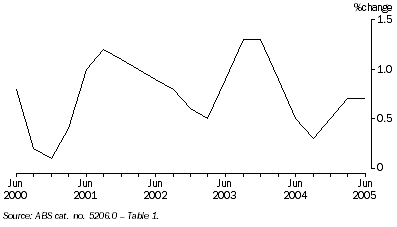 Graph 2: Employment, Month on month trend movements
Graph 2: Employment, Month on month trend movements
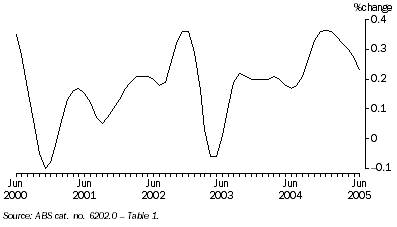
There are a range of other methods by which analysts examine time series. A common method, but not one supported by the ABS, is to derive a time series of seasonally adjusted growth rates in 'through the year' terms. This series is estimated by dividing the current quarter seasonally adjusted estimate by the corresponding estimate from the same quarter of the previous year. Graphs 3 and 4 show growth in GDP and employment in seasonally adjusted 'through the year' terms. It is evident that the implied turning points are noticeably later than those estimated using the trend estimates above, with GDP growth turning in June quarter 2004 and employment growth yet to turn (as at June 2005). Indeed, it can be shown that the identification of turning points in growth rates using 'through the year' methods will be roughly 2 quarters after the turning point defined using trend methods such as the Henderson method used by the ABS. This is a characteristic known as 'phase shift' and is simply a function of the way in which 'through the year' series are estimated. A technical note on these measurement issues has been appended to this article.
Graph 3: GDP, Volume measure - Through the year seasonally adjusted movements
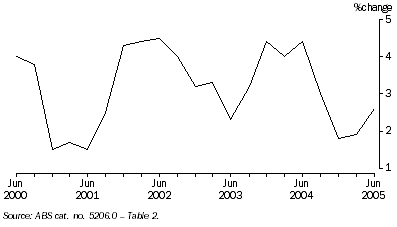 Graph 4: Employment, Through the year seasonally adjusted movements
Graph 4: Employment, Through the year seasonally adjusted movements
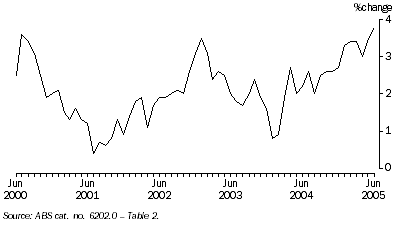
In terms of defining the precise timing of a turning point, the Henderson trend used by the ABS is superior to using 'through the year' analysis. The fact that the 'through the year' seasonally adjusted growth in employment has not yet turned may be one reason for the concern that the employment and GDP estimates are telling different stories about the economy. From our trend analysis, both series have had turning points in their growth rates in the last 18 months and show a typical lagged relationship between employment growth and GDP growth. The historical nature of this relationship is examined in the next section.
HISTORICAL RELATIONSHIP
Graph 5 highlights - using ABS Henderson trend movements - the relationship between GDP and employment over the past 25 years. Table 1 shows the lags in recent cycles between peaks in GDP growth and peaks in employment growth. The most recent lag between employment and GDP growth turning points of four quarters is not unusual in an historical context. Work by the ABS in 2004 (ABS cat.no. 1350.0 April 2004) showed that the strongest correlation between GDP and employment growth occurred after three quarters followed closely by lags of two quarters and four quarters. For this article that work was updated to include more recent data. Based on the latest analysis the strongest correlation between GDP and employment growth occurs after two quarters but with strong correlations also evident after three and four quarters. This work and other analysis suggest that while the nature of the relationship between the two variables evolves over time, both in terms of length of the lag and the strength of the correlation, a lag of four quarters as seen in the most recent cycle is not a particularly unusual outcome.
Graph 5: GDP and employment, Quarter on quarter trend movements
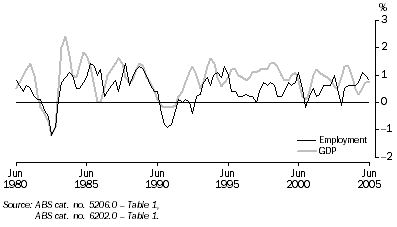
A further understanding of the nature of the historical relationship between GDP and employment can be obtained by examining the historical pattern of growth in GDP per hour worked - 'labour productivity'. Graph 6 shows that growth in hours worked and growth in employment are closely correlated. Given this close relationship, it is likely that, during the lags between peaks in GDP growth and employment growth, negative labour productivity growth will occur. Graph 7 and Table 2 show recent cycles when negative labour productivity growth was evident. The current run of four negative quarters is not unusual and the average size of the negative movement is only slightly larger than other recent runs of negative labour productivity growth.
Graph 6: Hours worked and employment, Quarter on quarter trend movements
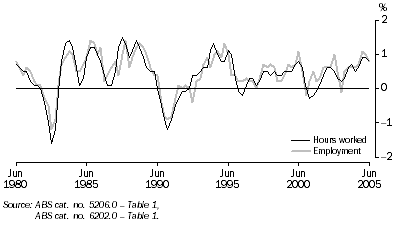 Graph 7: GDP per hour worked, Quarter on quarter trend movements
Graph 7: GDP per hour worked, Quarter on quarter trend movements
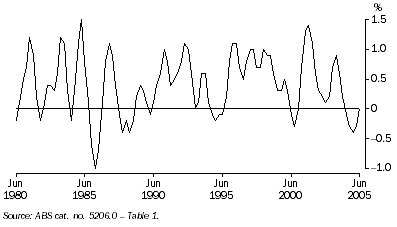
Table 2: Labour productivity |
|  |
 |  |  | Average percentage change
|  |
 | Periods of negative labour productivity | Number of negative quarters | GDP per hour worked | GDP | Hours worked |  |
|  |
 | Jun 04 to Mar 05 | 4 | -0.3 | 0.5 | 0.7 |  |
 | Jun 00 to Dec 00 | 3 | -0.1 | 0.4 | 0.5 |  |
 | Sep 94 to Jun 95 | 4 | -0.1 | 0.8 | 0.9 |  |
 | Dec 87 to Dec 88 | 5 | -0.3 | 1.0 | 1.2 |  |
 | Dec 85 to Jun 86 | 3 | -0.8 | 0.2 | 1.0 |  |
|  |
| Source: ABS cat. no. 5206.0 - Table 1. |
POSSIBLE ECONOMIC EXPLANATIONS
The existence of a lag between GDP and employment growth can be explained in broad terms. Initially, when a firm looks to increase production it is likely to do so by more fully utilising its current employees and it is only when it is clear that the increase in production is to be sustained that extra employees will be taken on. In part this reflects costs of training and incorporating new employees into a firm but there is also the time it takes to employ extra people. The reverse is also true when a fall in production occurs. It is only when such a fall is considered more permanent that shedding of labour would occur. While this broad explanation is a starting point there are many factors that may impact on the length and depth of the relationship at any particular point in time. The following section highlights several factors that are considered to be influencing the current cycle.
The first factor considered is the impact of the terms of trade. The growth in the terms of trade (measured as the growth in export prices relative to import prices) over the past two years has been very strong. It can be seen in Graph 8 that the current rates of growth have only been matched in the 1970s. One impact of an increase in the terms of trade is to give greater purchasing power to Australian producers. While GDP does not take this change in purchasing power into account, a measure of GDP adjusted for the terms of trade effect, Real Gross Domestic Income (RGDI) can be compiled. Graph 9 shows that since March 2004 RGDI has been greater than GDP reflecting the recent growth in the terms of trade.
Graph 8: Terms of trade index, Trend - (2003-04 = 100)
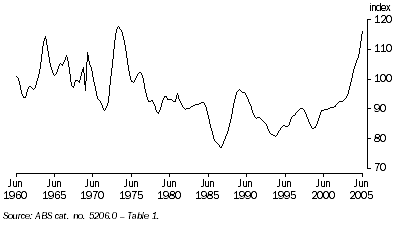 Graph 9: Volume GDP and RGDI, Trend
Graph 9: Volume GDP and RGDI, Trend
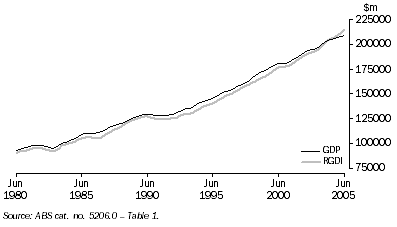
Comparing the quarter on quarter trend movements of GDP and RGDI (Graph 10) shows that the recent turning point in GDP growth is at the same time as the turning point in RGDI growth. However, the turning point in RGDI growth is much sharper and the overall trend in RGDI is stronger. Preliminary business cycle analysis shows a turning point in RGDI growth one quarter later than the turning point for GDP growth. It is possible that the decisions of employers, in the short run, are more influenced by changes in their real incomes than changes in their real output. Consequently, when the terms of trade is growing strongly, and hence when RGDI is growing more strongly than GDP, employers may be more inclined to hire (or not put off) staff even though growth in output volumes may have declined. In terms of the lagged relationship between output and employment growth, in a situation of strong growth in the terms of trade this logic would see a more normal lag between RGDI and employment and a longer lag between GDP and employment growth. The reverse would be true if the terms of trade were falling strongly.
Graph 10: RGDI and GDP, Quarter on quarter trend movements
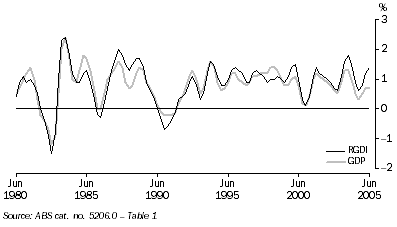
Preliminary modelling work by the ABS suggests that a distinct positive impact can be seen between an improvement in the terms of trade and improvements in GDP and employment, with the impact on employment being stronger. Further, although the terms of trade effect has only had a significant impact at certain times over the last 25 years, analysis suggests that there is a persistent impact from the terms of trade over the full time series.
The other factor considered is the impact of real unit labour costs. Graph 11 shows an index of real unit labour costs over the past 25 years. After a strong fall during the 1980s real unit labour costs growth was flat through the 1990s. Since 2001 real unit labour costs have declined steadily with some flattening in the trend in the last 12 months. One explanation of the nature of the lag between GDP and employment growth in the current cycle is that relatively low growth in real unit labour costs has allowed employers to continue to hire staff even though growth in output volumes has declined. This effect can be seen in Table 3 where growth in real unit labour costs for the past 5 periods of negative labour productivity growth are compared. Only during the long run of negative labour productivity growth in 1987-88 was the growth in real unit labour costs lower than during the current cycle.
Preliminary modelling work shows a distinct negative relationship between movements in labour costs and growth in employment and GDP with the impact on employment again being stronger. There seems reasonable support for the notion that relatively low real unit labour costs helped to maintain employment growth following the peak in GDP growth in December quarter 2003.
Graph 11: Real unit labour costs non-farm, Index (1986-87 = 100.0)
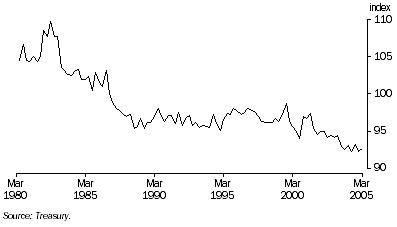
Table 3: Real unit labour costs |
|  |
 |  |  | Average percentage change
|  |
 | Periods of negative labour productivity | Number of negative quarters | GDP per hour worked | Hourly labour costs | Real unit labour costs non-farm |  |
|  |
 | Jun 04 to Mar 05 | 4 | -0.3 | -0.2 | -0.1 |  |
 | Jun 00 to Dec 00 | 3 | -0.1 | 0.1 | 0.5 |  |
 | Sep 94 to Jun 95 | 4 | -0.1 | - | - |  |
 | Dec 87 to Dec 88 | 5 | -0.3 | -0.7 | -0.4 |  |
 | Dec 85 to Jun 86 | 3 | -0.8 | 0.3 | 0.2 |  |
|  |
| - nil or rounded to zero (including null cells) |
| Source: Treasury, ABS cat. no. 5206.0 - Table 1. |
There are a range of other explanations that might assist in understanding the current relationship between GDP and employment. The nature of the current labour market, including the skills sets of recently employed people, the low levels of unemployment and concern over skills shortages, may be one contributing factor. There may also be industry specific issues, particularly for the mining and construction industries, that support the outcomes being observed at the aggregate level, although more analysis of the data is required to verify these impacts. It may also be that when peaks and troughs in trend GDP are relatively moderate, as has been the case recently, then the strength of the relationship between changes in GDP and changes in employment may be reduced.
Overall, this high level analysis supports the explanation that the combination of strong terms of trade growth and relatively small growth in real unit labour costs during the current cycle supports the notion that employment would grow relatively strongly compared to GDP. Further analysis and modelling of data is underway aimed at expanding our understanding of the issues. A feature article containing the results of this additional work will be released in the coming months.
POSSIBLE REVISIONS TO GDP
The possibility of revisions to GDP growth rates has led some commentators to conclude that the observed lag between GDP and employment growth would be reduced over time as the GDP estimates are revised. While it is quite likely that GDP would be revised, and indeed revisions to the quarters in the current cycle have already been published, the extent of revision required to fundamentally affect the currently published relationship between GDP and employment would be extreme. A more general revisions analysis is underway, but based on past studies the average revision to seasonally adjusted quarterly movements in GDP is less than 0.1 percentage points. The revision to trend movements is even smaller. Revisions of this magnitude to recent quarters would not be sufficient to move the location of the turning point in GDP growth rates in December quarter 2003.
POSSIBLE ERRORS IN THE ESTIMATES
The ABS strives to ensure that the statistics it compiles are error free but it is impossible to be totally certain that no mistakes have been made in compilation. We have undertaken extensive checks of the processes used in compiling both the GDP and employment estimates and have found no cause for concern from a statistical perspective. Furthermore, we have considered what might cause an error to either the GDP or employment estimates that would significantly distort the relationship in the turning points in the growth rates for the series and we have been able to dismiss all the 'hypotheticals' we have conceived.
CONCLUSION
The relationship between GDP and employment can be affected by many factors. As a starting point for analysis it is important to understand the underlying behaviour of the data. The use of Henderson trends as compiled by the ABS is a more appropriate method of understanding these behaviours and turning points compared to analysing seasonally adjusted data in 'through the year' terms.
The analysis concludes that recent turning points in GDP and employment growth rates can be defined, with the lag being four quarters. This is a slightly longer lag than on average but it is well within reasonable bounds. Two particular factors, strong growth in the terms of trade and relatively weak growth in real unit labour costs, seem to be contributing to the slightly longer than average lag but further analysis of the impact of these and other factors is required.
Further work to analyse the relationship between GDP and employment is underway. A comprehensive article on this topic is planned for release in coming months.
FURTHER INFORMATION
For further information on the analytical and statistical issues discussed in this article please contact Carl Obst by phone (02) 6252 6646 or by email carl.obst@abs.gov.au.
REFERENCES
ABS (April 1991), 'Picking Turning Points in the Economy', Australian Economic Indicators (cat. no. 1350.0)
ABS (August 2003), A Guide to Interpreting Time Series - Monitoring Trends (cat. no. 1349.0)
ABS (April 2004), 'Leading Indicators of Employment', Australian Economic Indicators (cat. no. 1350.0)
TECHNICAL NOTE: ISSUES IN THE USE OF THROUGH THE YEAR MEASURES OF GROWTH
Users wishing to analyse time series data often calculate the growth between the current period and the same period a year ago. The results of this data transformation are usually referred to as 'through the year' growth rates. Most often 'through the year' growth rates are calculated on seasonally adjusted data. In cases where the underlying behaviour of the series is fairly constant - i.e. without notable turning points in level, changes in growth rates or irregular observations - the use of 'through the year' growth rates is a useful and quick method of defining a current period annual growth rate from monthly or quarterly data. However, most economic time series contain turning points in level, changes in growth rates and irregular observations and, as a result, the use of 'through the year' growth rates can generate misleading results, particularly with respect to the precise timing of any turning points or points of inflection. This technical note explains the reason for the misleading results. The ABS recommends that users analyse turning points and the general underlying behaviour of time series using the quarter on quarter movements in trend series such as those compiled by the ABS.
The first concern in using 'through the year' growth rates is that they are distorted by the seasonal and irregular effects which are different in each period. When applied to original or unadjusted data 'through the year' growth rates perform a crude seasonal adjustment because the comparison of like months or quarters reduces the impact of the constant yearly seasonal effects. However, because of gradually changing seasonal patterns these effects are rarely eliminated. Calculating 'through the year' growth rates in seasonally adjusted terms produces a measure which is free of the distortion of the calendar related influences but the rates are still influenced by the irregular fluctuations which will differ in every period. Trend estimates are largely able to remove the impact of differential irregular effects over time and hence can provide a better measure of the underlying behaviour of a time series.
The second concern is that even when the 'through the year' growth rate reflects a substantial contribution from the trend, the transformation does not define the timing of turning points in underlying series behaviour accurately and will normally identify a turning point 1.5 quarters after the turning point identified by quarter on quarter movements. To understand this issue graphs 1 and 2 are instructive. The first graph defines a quarterly time series in levels and movement terms. It shows that as peaks or troughs are reached in the levels, the growth rates will turn beforehand. Thus as a general statement turning points in growth rates will occur before turning points in levels.
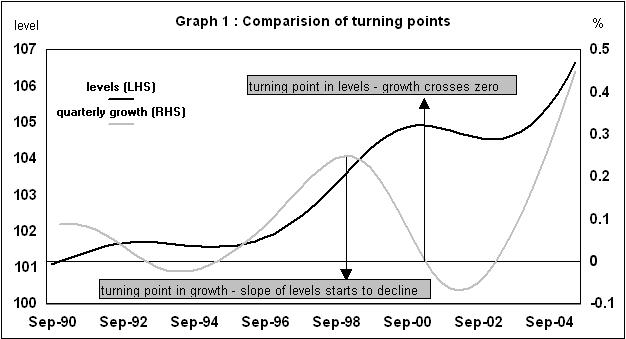
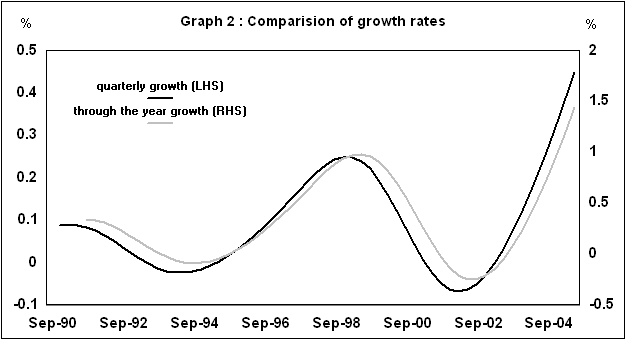
However, in terms of the series itself the direction of the series is determined exactly at time t by calculating the gradient of the series at that point. A positive gradient indicating the series is increasing, a negative gradient indicating the series is decreasing. The gradient is the slope of a particular straight line passing through the series, called the tangent to the curve, at time t. Three tangents have been defined in the graph below, one each for the three points (A, B and C) at which 'through the year' growth rates have been measured. The tangent lines are defined as A', B' and C'.
Since these three tangents define the true direction of the series at any point in time the aim is to best approximate these tangents. In this sense, the 'through the year' lines A, B and C can be seen as approximations of the tangents A', B' and C'. However, as can be seen by comparing these sets of lines in the diagram below, the lines A, B and C are actually very poor approximations to the slope of the corresponding tangent. In the figure below, the slope of the 'through the year' growth measure remains positive many months after the trend peak in March has been passed and only becomes negative when the month of December is reached (C), nine months later. Hence, the 'through the year' growth measure would indicate that the turning point of the series occurred in December, rather than the month of March in which it actually occurred.
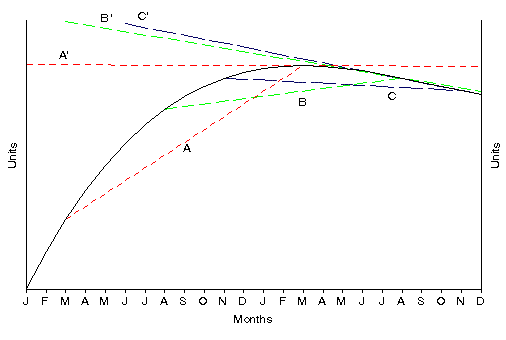
 Print Page
Print Page
 Print All
Print All